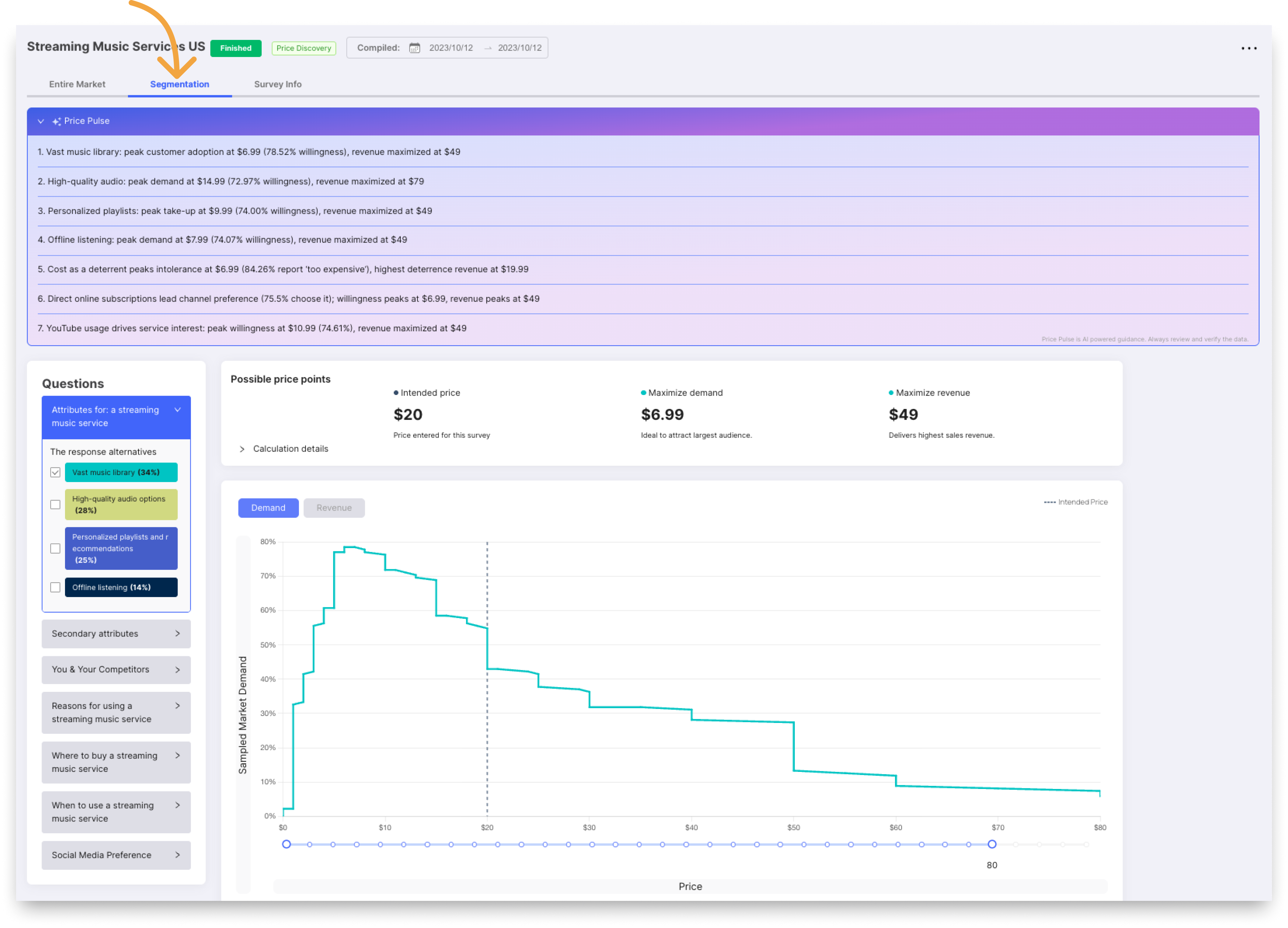Segmentation Analysis
The ability to go beyond a broad market view and perform a granular Segment Analysise allows you to drill down into your survey data to understand how specific customer groups — or segments— perceive value and respond to pricing differently.
ℹ️ Note: Segmentation analysis is only available for Price Discovery studies.
We use segmentation analysis to break down the total audience into smaller, more focused groups. We then use a drill-down approach to analyze each group in detail. This process lets us see how different attributes, features, or messages affect willingness to pay for specific segments. Instead of a single, broad view of the market, you get a clear, granular picture of what matters to each audience. For example, some customers may value a product's high-quality materials, while others are more influenced by its sustainability features. We find those drivers.
Where to find
The segment result and analysis is available for Price Discovery studies. In the results page, swap to the Segment tab to begin drilling down.
- Review segments by selecting what question and what responses you want to drill down to on the left hand side of the chart
- You can filter within the chart on respondent data (age, gender, income)

Why Segment Analysis Matters
While a single optimal price point is valuable, it is rarely the full picture. Not all customers see value in the same way, and their willingness to pay can vary significantly based on demographics, geography, behavior, or other characteristics. A lack of this granular insight can lead to a "one-size-fits-all" pricing strategy that leaves revenue on the table by underpricing for some segments and overpricing for others. Segment Analysis directly addresses this by providing the intelligence needed for a more precise, targeted approach.
Segment size
The segment size provides the essential context for your segment analysis. A pricing strategy may appear highly profitable for a specific segment on paper, but if that segment represents only a small fraction of your total market, the overall business impact might be indifferent. Understanding the size of each segment allows you to prioritize your efforts and allocate resources effectively. It helps you decide whether to focus on a high-value, niche segment or to optimize for a larger, more general one. By combining the insights from your segment's willingness to pay with its overall size, you can make more informed strategic decisions that maximize both revenue and market share.

Use Cases / Examples
- Developing a Premium Tier: A company finds that a segment of its customers (e.g., professionals aged 35-50 with high income) has a significantly higher willingness to pay than the general market. They use this insight to create a new premium product version with enhanced features and a higher price point, confident it will be adopted by this segment.
- Geographic Price Optimization: A global company notices that demand in a specific country is far more sensitive to price changes than in its core markets. Using Segment Analysis, they justify implementing a lower, localized price to maximize market penetration in that region.
- Targeted Marketing: By identifying which demographic segments value a specific product feature most highly, a marketing team can craft tailored messaging and campaigns that speak directly to the value drivers of that group, improving conversion rates.
Key Benefits & Outcomes
- Identify High-Value Segments: Pinpoint which customer groups are your most profitable, allowing you to focus resources on acquisition and retention strategies for these key audiences.
- Precision Pricing: Move from a single price point to a tiered or segmented pricing model that captures the full value from each customer group, maximizing overall revenue.
- Strategic Go-to-Market: Inform your go-to-market strategy by understanding which features and benefits resonate with which customer segments.
- Data-Driven Customization: Use empirical data to justify customized product bundles, marketing campaigns, and sales strategies, eliminating guesswork and increasing effectiveness.
